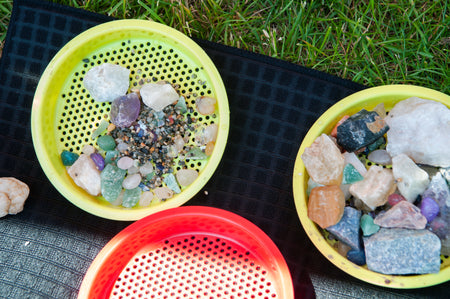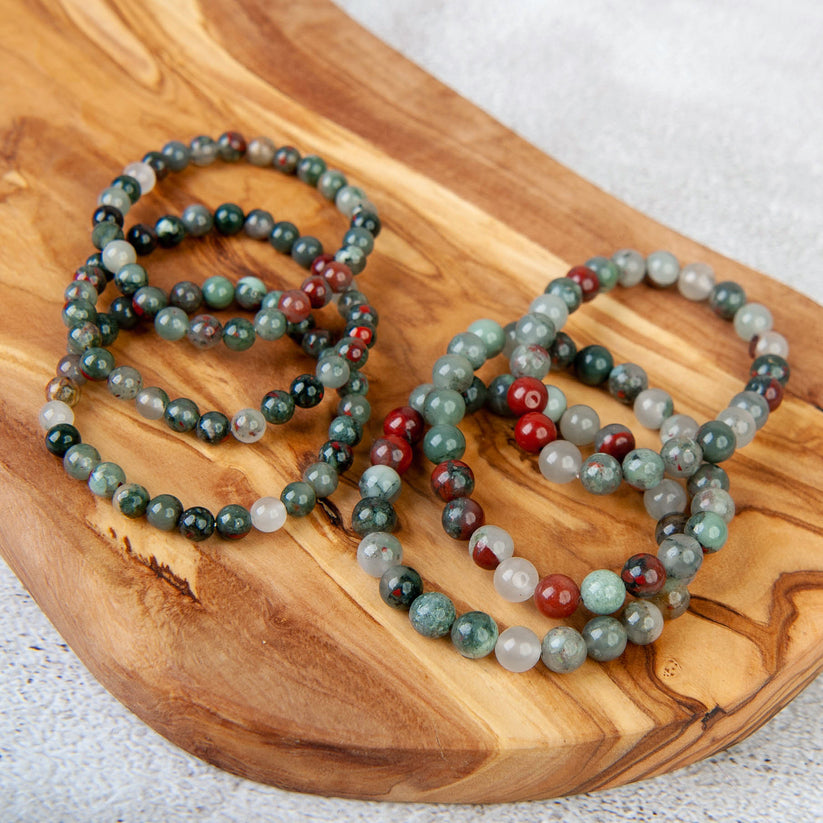How to Identify a Rock or Gemstone
Article by Rezolutions Design
$0.00 USD
Article by Rezolutions Design

There is an almost endless list of rocks and minerals out there, and trying to identify them all can seem daunting. They come in different colors, shapes, and sizes, which makes it even more difficult.
However, with a bit of knowledge and practice, you'll easily identify most rocks and gemstones. You'll have to think like a geologist, though, and use various inherent properties of the rock or gem to identify it.
Here are some tips on how to identify a rock or gemstone:
Most common rocks and gems can often be identified in the field using basic physical properties such as color, shape, hardness, luster, grain size & shape, texture, banding or foliation, and cleavage & fracture.
Observing and comparing these properties with those of a known sample is often the best way to identify an unknown rock or gem. You'll need to go through a systematic process of elimination to identify your specimen.
Let's take a look at each of these properties in detail:
Color
The color of a rock or gem can give you important clues about its identity. It can either be mono-colored or have multiple colors. Some rocks and gems can even change color when viewed in different lighting conditions.
Rocks have different colors because of their chemical and mineral composition. While there's no sure way to identify a rock based on color alone, it can be helpful in combination with other properties.
A general rule of thumb is that igneous rocks tend to be lighter in color, while sedimentary and metamorphic rocks are usually darker.
Here are some examples of gems that are easily identified by their color:
- Turquoise: a blue or bluish-green gemstone
- Lapis lazuli: a deep blue rock
- Rhodochrosite: a pink to red gemstone
- Rhodonite: a black, white, and pink rock
- Jasper: an opaque, multi-colored gemstone
- Quartz: a transparent, translucent, or white gemstone that comes in many colors. Tiger eye. Amethyst, aventurine, and agates are all varieties of quartz with impurities in them to cause their distinctive color.
- Amethyst: a violet gemstone
- Emeralds: a green gem due to trace amounts of chromium or sometimes vanadium.
Shape
A rock or gem's shape can give clues about how it was formed. Igneous rocks, for example, are often found in the shape of hexagonal columns. On the other hand, Sedimentary rocks are usually more irregular in shape. Metamorphic rocks can have a wide variety of shapes, depending on the type of rock they started out as.
Gems are often found in crystalline shapes, which has flat surfaces that meet at angles. The most common crystal shapes are cubic, hexagonal, and trigonal.
Texture
The texture of a rock is its overall shape, size, and arrangement of crystals (for metamorphic and igneous rocks) or grains (for sedimentary rocks). This rock microstructure can often be seen with the naked eye or under a microscope. It is an important aspect of identifying rocks, as different types of rocks have different textures.
There are three main types of textures:
- Phaneritic: a coarse-grained texture in which the individual grains are visible to the naked eye
- Aphanitic: a fine-grained texture in which the individual grains are not visible to the naked eye
- Porphyritic: a texture that is a mix of phaneritic and aphanitic, in which some of the grains are visible to the naked eye while others are not
To identify the texture of a rock, you will need to look at it closely.
- Igneous rock's textural features: The texture of an igneous rock is determined by the rate at which it cooled. If it cooled quickly, it will have a fine-grained or aphanitic texture. If it cooled slowly, it will have a coarse-grained or phaneritic texture.
- Sedimentary rock's textural features: The texture of the sedimentary rock is determined by the size, shape, and sorting of the sediments that make it up. The rock will have a coarse-grained texture if the sediments are large and well-sorted. If the sediments are small and poorly sorted, the rock will have a fine-grained texture.
- Metamorphic rock's textural features: The fabric of metamorphic rock results from the growth of new minerals and the re-orientation of pre-existing minerals during metamorphism. The texture of a metamorphic rock is described by its foliation which is the degree to which its minerals are aligned with each other.
Grain Size
The grain size of a rock is a measure of the size of the individual grains that make up the rock. Igneous rocks can have a wide range of grain sizes, from very fine to very coarse. The grain size of sedimentary rock is usually determined by the type of sediment it contains. For example, sandstone is typically composed of grains that are 0.06-2 mm in diameter, while shale is usually composed of smaller grains.
Hardness
A rock or gem hardness is another important identifying feature. The hardness of a rock or gem is a measure of its resistance to scratching, abrasion, or breaking. The Mohs scale is the most commonly used scale for measuring hardness. It is a 10-point scale that ranks minerals from 1 (softest) to 10 (hardest).
Talc, for example, has a Mohs hardness of 1. This means it can be easily scratched by a fingernail. Diamond, on the other hand, has a Mohs hardness of 10. This means it can only be scratched by another diamond.
A rock hound can determine a rock's hardness by testing it with a hammer or by using the scratch test. The scratch test involves scratching the rock's surface with another object of known hardness. If the rock being tested is harder than the object it is being scratched with, then it will not leave a mark.
You'll need a knife or steel nail and glass to do a scratch test. First, try to scratch it with your fingernails to see if it leaves a mark. Second, try scraping the rock with the knife blade. If it scratches the rock, then it is harder than 3 on the Mohs scale.
Now use the glass plate. First, see if you can scratch the rock's surface with just the glass plate. If so, then it has a hardness of 5.5. Second, try to scratch the glass plate with the rock. If you can do so, then the rock has a hardness of 7 or higher on the Mohs scale.
How can you use hardness to identify a rock?
If a knife or fingernail can easily scratch a rock, it is likely to be a sedimentary rock such as limestone or shale. On the Mohs scale of hardness, these rocks would rate a 3 or 4. If a rock can scratch glass but not steel, it is probably granite, which rates a 7 on the Mohs scale.
Classify the rock as either:
- Very soft: This rock can be scratched with a fingernail and has a Mohs hardness of 2.5 or less.
- Soft: This rock can be scratched with a knife blade and has a Mohs hardness of 3 to 5.5.
- Moderately hard: This rock can scratch glass and has a Mohs hardness of 6 to 7.
- Hard: This rock can scratch steel and has a Mohs hardness of 8 to 10.
Luster
A rock or gem's luster is how light reflects off of its surface, leading to a shine or sparkle. It can range from dull, shiny, to metallic. The best way to determine a rock's luster is to look at it in a well-lit area.
To determine luster, observe how light reflects off the rock's surface. Is the reflection even, or does it vary in intensity? Does the light reflect off in a single direction, or does it scatter in many directions?
- Dull: The rock's surface is not shiny and does not reflect light well.
- Shiny: The rock's surface is smooth and evenly reflects light.
- Metallic: The rock's surface is shiny and reflects light in a single direction.
Banding or foliation
This is mainly a unique identifier for metamorphic rocks. Banding is the alternating light and dark layers visible in some rocks. Foliation is when the bands are flattened into sheets due to the high pressure that was exerted on the rock during its formation.
To determine if a rock has banding or foliation, look at it closely to see if there are any visible layers. If so, then it is likely that the rock has banding or foliation, making it a metamorphic rock.
There are three main types of foliation:
- Slaty: minerals are aligned in flat, sheet-like layers
- Schistose: minerals are aligned in broken, flaky layers
- Gneissose: minerals are aligned in wavy layers
Cleavage & fracture
Cleavage is the way a rock breaks along certain planes of weakness in its structure. Fracture is the way a rock breaks along any plane. The two are not always the same.
What can cleavage and fracture tell you about a rock?
Cleavage planes are almost always at right angles to each other. A rock with two cleavage planes intersecting at 90 degrees is said to have perfect cleavage. Rocks with this type of cleavage can be split into thin sheets.
Fracture, on the other hand, can occur at any angle. A rock with a fracture surface that is rough or jagged is said to have an irregular fracture. A rock with a fracture surface that is smooth and even is said to have a regular fracture.
So, how can you use cleavage and fracture to identify a rock?
- A rock with perfect cleavage will split easily into thin sheets. This is a characteristic of minerals such as mica and talc.
- If a rock has an irregular fracture, it is likely to be a sedimentary rock such as sandstone or shale. These rocks are made up of smaller pieces that have been cemented together.
- A rock with a regular fracture is likely to be a metamorphic rock such as gneiss or marble. These rocks have been subjected to high temperatures and pressures, which have caused their minerals to re-crystallize.
Now that you have analyzed the physical properties of your rock, it is time to compare them with other known rocks. This will help you to identify what type of rock you have.
There are three main types of rocks: sedimentary, metamorphic, and igneous. Sedimentary rocks are made up of smaller pieces that have been cemented together. Metamorphic rocks have been subjected to high temperatures and pressures, which have caused their minerals to re-crystallize. Igneous rocks are made of cooled lava or magma.
To identify your rock, compare its properties with the following descriptions:
- Sedimentary rocks:
Sedimentary rocks are usually soft and have a grainy texture. They are often found in shades of brown, red, and grey. Common sedimentary rocks include sandstone, shale, and limestone.
- Metamorphic rocks:
Metamorphic rocks are often hard and have a foliated or banded texture. They can be found in a wide range of colors, from black to white. Common metamorphic rocks include gneiss, slate, and marble.
- Igneous rocks:
Igneous rocks are usually hard and have a glassy or crystalline texture. They can be found in a wide range of colors, from black to white. Common igneous rocks include granite, basalt, and obsidian.
A rock identification chart can help you confirm the identity of a rock or gemstone. Many charts are available online or in geology books that list the different physical properties of rocks and gemstones. Simply compare the physical properties of your rock with those listed on the chart. If your rock matches the description of a particular type of rock or gemstone, then you may have found your answer.
Of course, not all rocks and gemstones will fit neatly into one of the categories on a chart. In that case, you can try to find the closest match possible. Or, you can consult with a geologist or another expert to get a more definitive answer.
If you want to get serious about rock and gem identification, then you may want to invest in a rock and gem mining bucket. These buckets contain a variety of rocks and gemstones, along with a guide that will help you identify them. This is a great way to get started in the world of rock and gem collecting.
At Declan's Mining Co., we offer a variety of rocks and gemstones for sale. We also offer a rock identification chart that can help you to identify the type of rock or gemstone you have.
Our rock identification chart includes the following information:
- Rock Type
- Description
- Physical Properties
- How to Identify
If you have questions about our rock identification chart or any of the rocks and gemstones we offer for sale, don't hesitate to contact us. Our experts would be happy to help you identify your rock or gem.

Sign up now and enjoy a 10% discount on your first purchase. Start your mining adventure today!
Sign up now and enjoy a 10% discount on your first purchase.
Explore
Learn
Explore
Learn
Get In Touch
Sign up now and enjoy a 10% discount on your first purchase.
© 2026 DECLAN'S MINING CO. - ALL RIGHTS RESERVED.
